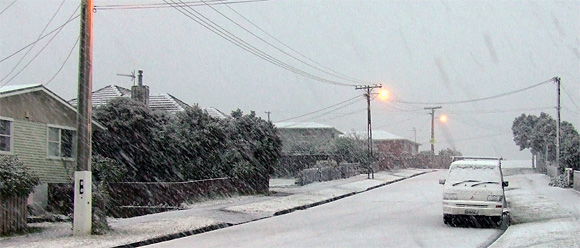|
Zeitblick
- Series
|
| City,
My City - Series Five By Peter Wells |
|
|
Historic Wellington - A city is made up of many things; its people of course, its buildings, its landmarks and it boundaries. Most of all however a city is constituted by its streets, the skeleton on which the body of the city is formed. Many cities are an expansion of an existing settlement, village or township while others, such as Wellington, are built from scratch. The original plans of Wellington (initially to be known as Britannia) were drawn up in London with little or no knowledge of the topography of the land surrounding Port Nicholson. Locations were identified, streets named and the fledgling city crammed into what little flat land was available on the southern shores of the harbour. Most of those street names remain today, of course, and the original routes they took are, in the main, unchanged. This next series of stories for Zeitblick looks at the history behind some of the key Wellington, how they came into being, why they were named and changes that have occurred to them over the last 170 years. |
|
Series 5 / Part 1
Some of the stories about Wellington fall into the category of future historic events. "The Day the Snows Came" will, in future, be just such an event. Situated where it is at the confluence of two great bodies of water, the Tasman Sea and the Pacific Ocean, Wellington traditionally has it's strong winds and a significant amount of rainfall. In fact the term "Windy Wellington" is one that residents grow up with and tend to guard jealously. Much of the literary tradition of Wellington makes reference to fierce winds, cold southerlies and the "blow hole" of Cook Strait on whose shores the city is situated. It is a well-known historical fact that until relatively recently some of the most notoriously windy corners of the city had safety ropes affixed to the walls of buildings for pedestrians to grip if necessary in strong winds, something akin to the safety ropes of tall ships at sea. One thing, however, that Wellington doesn't have a huge amount of is snow...and even then this usually rests on the peaks of the higher hills and mountain ranges surrounding the district. Many of us were therefore surprised, awed and inwardly delighted when a cold front dumped snow over most of the country on August 13th through 15th. Wellington and much of New Zealand, was covered in a cold white blanket, an event which had last occurred in 1939. This story tells of this event, memorable for the rest of ones life? |
Series 5 / Part 2 Write-up to be done - Relics, ruins and historic locations are common to all countries around the world. Many countries may boast thousands of years of history and historic sites that hark back to those very early times while others such as the United States and Australia still measure their pedigree by a mere few hundred years. At a scant 170 years this makes New Zealand the "new kid on the block" and while we don't have ancient castles, crumbling ruins or buried treasure, we do have notable locations which mark key moments in our history. The fortified locations of Wellington, and by extension the rest of New Zealand, are examples of these locations and each of these, coupled with other significant sites built for different purposes, tells of important steps in the development of this nation. From the "apron strings" of colonialism to the obedience of dominion and the autonomy and complete independence of nationhood, New Zealand has won a respected place in the world and it has often been said that we are a small nation who "punches above its weight". The fortresses of Wellington, along with those in our other cities, are part of the development of this attitude to life. |
Series 5 / Part 3 As is common in many cities around the world many of the streets of Wellington are named for those who have had a significant impact on the formation of this city. Several streets bear the names of members of the New Zealand Company, our founding fathers if you will, while others carry the names of local merchants or citizens of renown and still others are named for their location. “Customhouse Quay”, for instance, was named because this was where the early port customs building was located. Featherston Street is named for Dr IE Featherston, an early settler and one whose impact on and contribution to Wellington city, Wellington Province and New Zealand as a whole. His contribution to the people and the social and political development of New Zealand is recognised in a street and a township named “Featherston”. |

